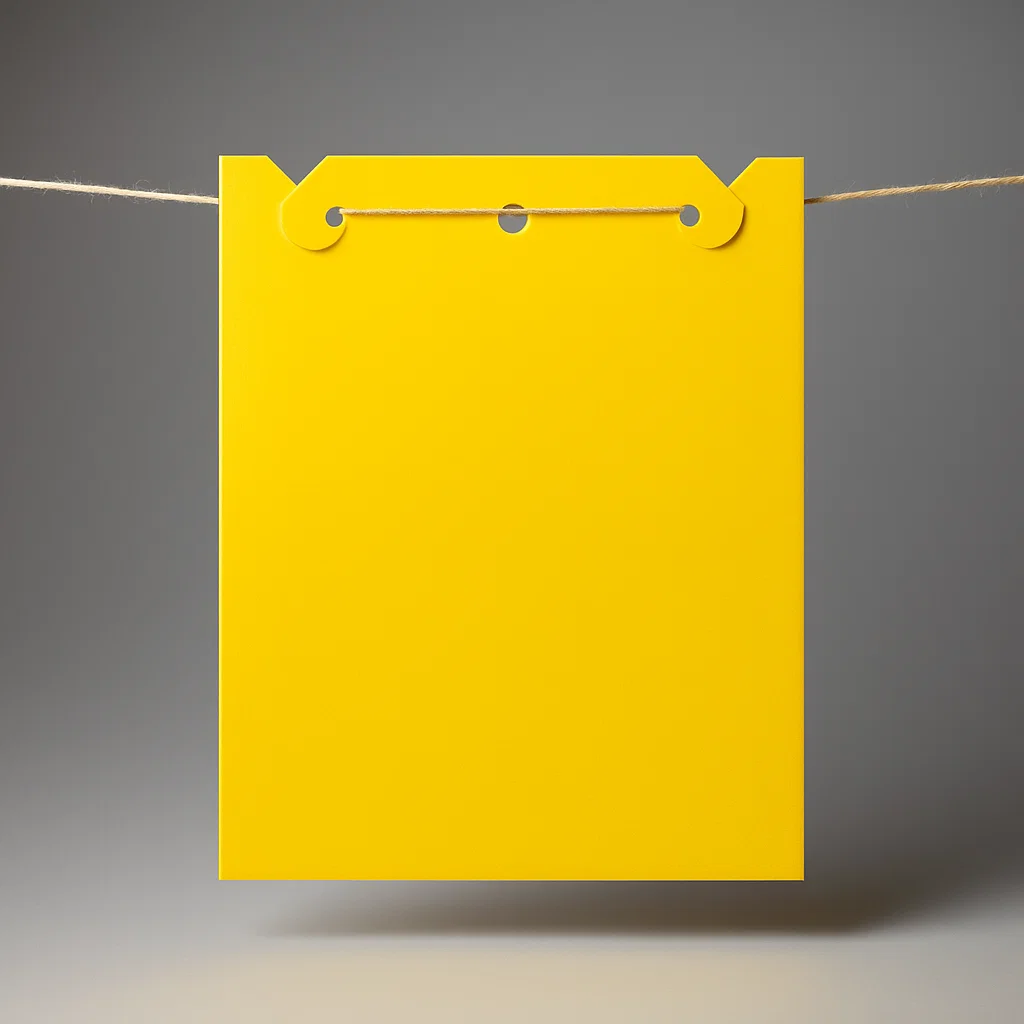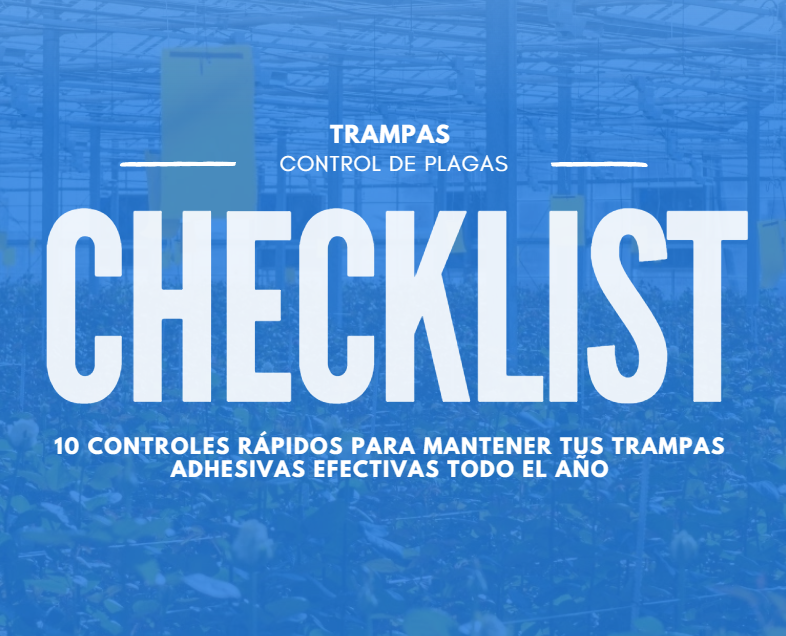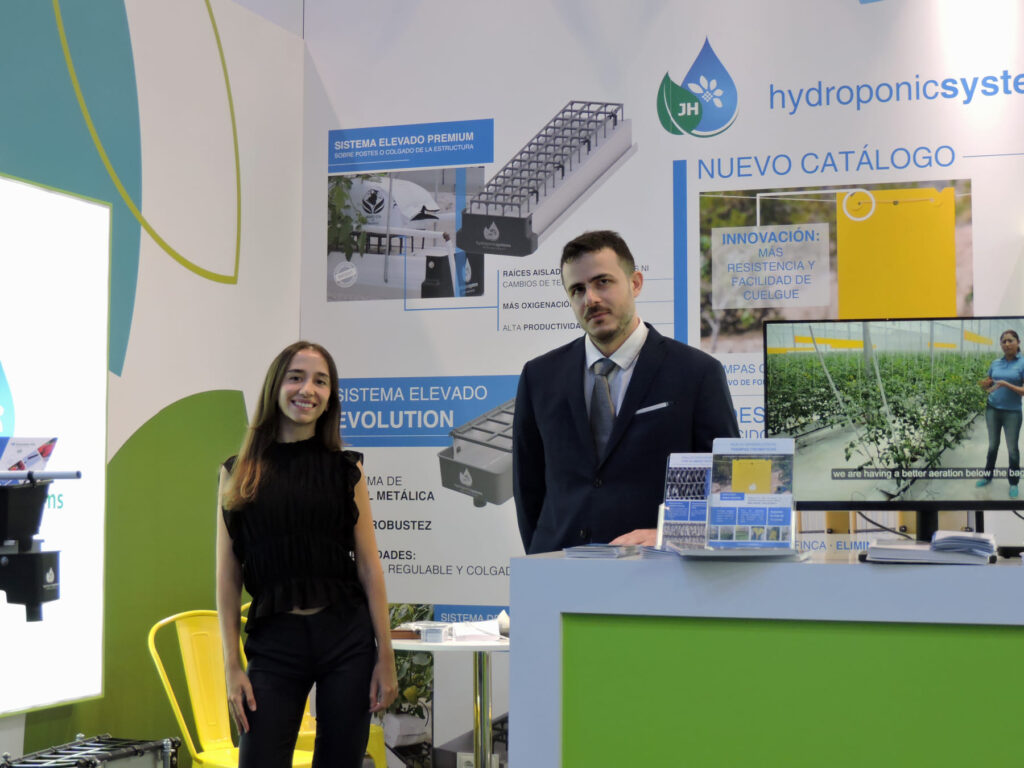A sticky trap is only truly effective if properly placed. The installation height directly influences the number of insects captured, as many pests fly or move at different heights depending on the crop and its growth stage.
In strawberry or lettuce crops, traps should be placed at foliage height, just above the tallest leaves. In tomato, pepper, or cucumber crops, they should ideally be placed between the top third of the plant and the middle of the canopy, adjusting their position as the plant grows. For ornamentals or cut flowers, it is recommended to place traps both at crop level and in transit areas to detect potential entry points.
Always avoid traps coming into contact with leaves, stakes, or metal structures, as this can reduce the available adhesive surface or accumulate dust and plant debris. Correct placement of sticky traps ensures realistic monitoring and uniform pest capture throughout the greenhouse.
Technical tip: Check the height and replacement of traps weekly, especially during peak vegetative growth or after pruning. Keeping them visible and well-positioned can make the difference between detecting an infestation early or losing a portion of your crop.
10 quick checks you can't forget to keep your sticky traps in tip-top condition

Follow this routine to ensure your chromatic traps are working at their best year-round. Simple but consistent maintenance can make the difference between detecting a pest in time or facing an infestation that affects your crop’s yield.
Check 1: Check the correct placement and height
The placement of sticky traps is one of the most important factors in determining their effectiveness. Each type of pest moves at different heights, so it’s essential to adapt the location to the type of crop.
In low-growing crops such as strawberries or lettuce, place the traps at foliage level, just above the upper leaves. For tomatoes, peppers, or cucumbers, it is recommended to place them in the upper third of the plant, adjusting their position as the crop grows. For ornamentals or cut flowers, it is advisable to combine traps within the crop and others near access points to detect external sources.
Always avoid direct contact with leaves, wires, or metal structures, as this can reduce the adhesive surface or accumulate dust and plant debris. Correct placement of sticky traps ensures more accurate monitoring and consistent capture throughout the greenhouse.
Control 2: Check the light exposure
Trap visibility is key. Colored traps work because they attract insects through their color, but if they are shaded or covered by crop growth, they lose much of their effectiveness.
Regularly check that all traps are evenly exposed to natural or artificial light. As the crop grows or is pruned, adjust their location. In winter, when the sun shines lower, it may be helpful to raise the traps slightly to maintain their effectiveness.
Control 3: Check the integrity of the adhesive
Over time, dust, moisture, or insect debris can reduce the trap’s capture capacity. Check to see if the adhesive maintains its sticky, uniform texture.
Hydroponic Systems traps feature a 91% active adhesive surface area, the highest on the market, which extends their life and maintains a constant attraction to insects. This feature allows for longer inspection intervals without loss of performance.
If you notice dry or saturated areas, replace the trap immediately: a partially inactive trap can give a false sense of control and underestimate the true pest density.
Control 4: Periodic replacement according to pest density
Not all traps should be changed at the same time. The frequency of replacement depends on the type of crop, the time of year, and pest pressure. As a general rule, replace them every few weeks, or sooner if the sticky surface is saturated with insects.
Monitoring the replacement cycle ensures that the traps accurately reflect the condition of the greenhouse and do not lose their early detection capabilities.
Control 5: Cleaning the surroundings
The environment where the traps are placed also plays a role. Dust, plant debris, pollen, or loose plastic floating in the air can stick to the trap and reduce its effectiveness.
A light cleaning routine in the area where the traps are placed improves air circulation and color visibility, promoting more consistent capture. In tunnels or closed greenhouses, it’s a good idea to clean the structures and walkways once a week to keep the traps free from interference.
Download the full list below to see the 10 steps of control:
The effectiveness of sticky traps depends not only on the product itself, but also on the care with which they are maintained. With these 10 quick checks and the proven quality of Hydroponic Systems traps, you can ensure consistent capture, reduce the use of pesticides, and keep your greenhouse free of surprises all year long.
Why choose color traps with 91% adhesive surface
When it comes to greenhouse pest control, not all sticky traps are created equal. One of the main differences lies in the available adhesive surface: while many standard traps offer standard percentages of adhesive surface, Hydroponic Systems traps achieve 91% adhesive surface, the highest on the market.
| Standard trap | Hydroponic Systems Trap | |
| Adhesive surface | Around 80% | 91% |
| Resistance to deformation | Medium | High |
| Installation time | Medium | Very fast: more than 1,100 minutes saved per hectare |
| Capture efficiency | Moderate-High | Superior-Maximum |
Download the full list below to see the 10 steps of control:
Key Benefits of Double Hook Traps
Superior capture through a larger usable area:
More adhesive means more space to trap insects, increasing monitoring effectiveness and allowing pests to be detected before they reach critical levels.
Reduced change frequency:
Thanks to their large sticky surface and durable material, these traps require less frequent replacements, reducing costs and handling time.
Non-deforming:
Their robust design and durable materials ensure they maintain their shape even in humid environments or during hot weather, ensuring constant exposure of the entire adhesive surface.
Faster installation:
The ease of assembly and optimized double-hook design allow multiple traps to be placed in minutes, saving labor and ensuring even distribution throughout the greenhouse.
With these advantages, Hydroponic Systems’ double-hook traps become a reliable and efficient tool, key to any integrated pest monitoring and control system in modern greenhouses.
FAQ: Frequently Asked Questions About Chromatic Traps
How often should I change the sticky traps in my greenhouse?
The ideal replacement frequency depends on pest pressure and crop type, but as a general guideline, it’s recommended to replace traps every few weeks.
If the trap becomes saturated with insects before this period, it loses effectiveness and should be changed immediately. In high-density crops or during temperature spikes, it may be necessary to do so more frequently.
💡Technical tip: Use traps with a wide adhesive surface—such as Hydroponic Systems traps—to space out replacements without losing capture capacity.
How to prevent traps from losing their stickiness due to moisture?
Humidity is one of the main factors affecting the performance of chromatic traps. To avoid this:
– Install them in well-ventilated areas without direct condensation.
– Make sure they are not in contact with leaves or metal structures.
– Choose traps made with moisture-resistant adhesives, such as those from Hydroponic Systems, which maintain their stickiness even in humid environments or after frequent watering.
👉 With 91% active surface area and high-quality materials, these traps maintain their effectiveness for longer.
What does it mean when a trap has 91% adhesive surface?
This means that 91% of the trap’s total surface area is covered by functional adhesive, leaving only a small margin for handling or hanging.
In comparison, many standard traps offer 70% or 80% coverage, which limits the actual capture area.
This difference allows Hydroponic Systems traps to catch more insects, delay saturation, and offer greater accuracy in pest monitoring, with fewer replacements throughout the year.
Simple maintenance, consistent results
In greenhouse management, great results don’t always depend on large investments, but rather on consistency in the small details. Checking, cleaning, recording, and replacing sticky traps on time can make the difference between a healthy crop and a significant loss of production.
With Hydroponic Systems traps, maintenance becomes simpler and more reliable. Their durable design, 91% adhesive surface, and quick installation ensure consistent pest control, even in the most demanding conditions.
In addition, the Hydroponic Systems technical team supports growers with personalized advice to design the best check and replacement schedule, tailored to each crop type and the greenhouse’s seasonal variations.




